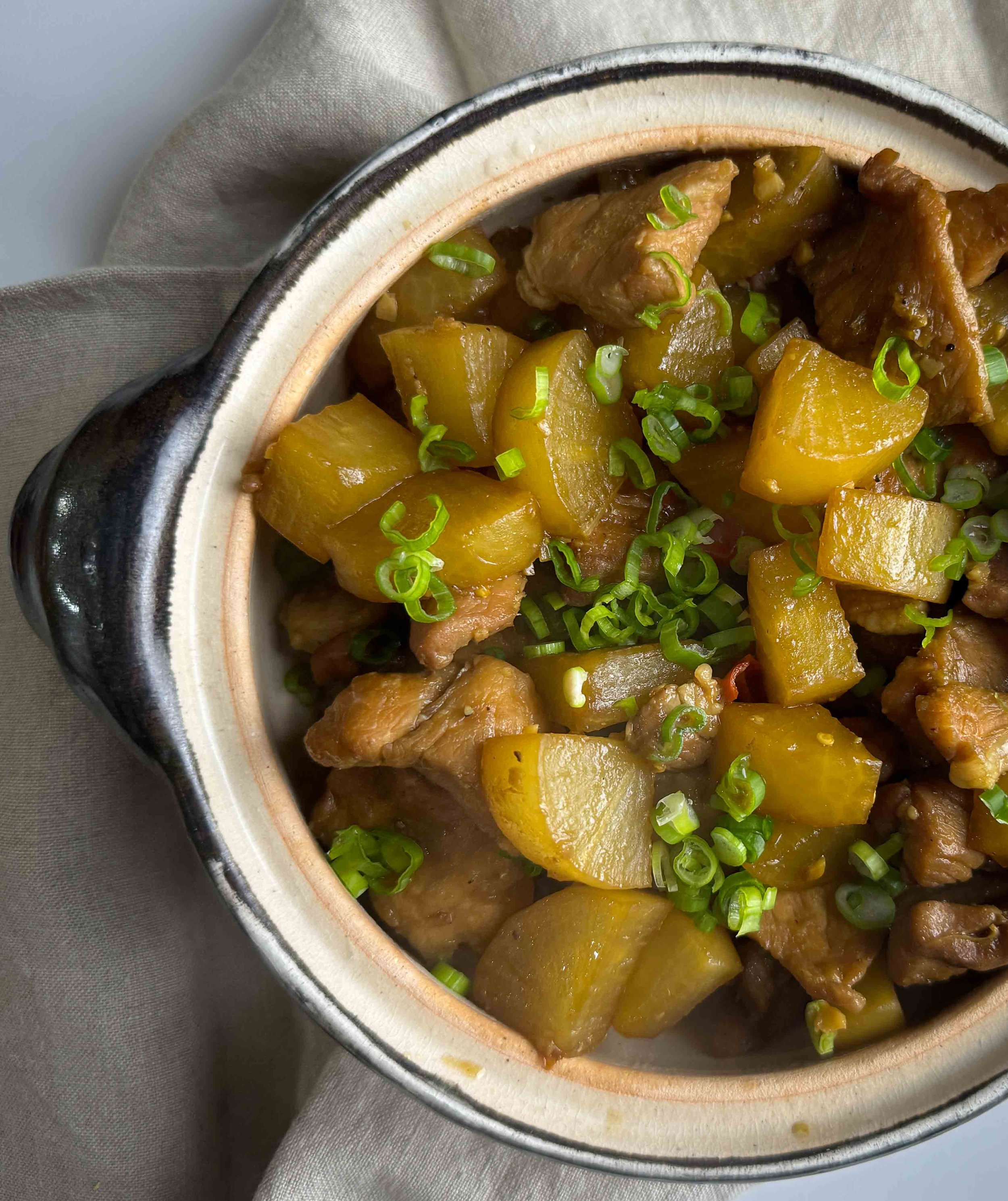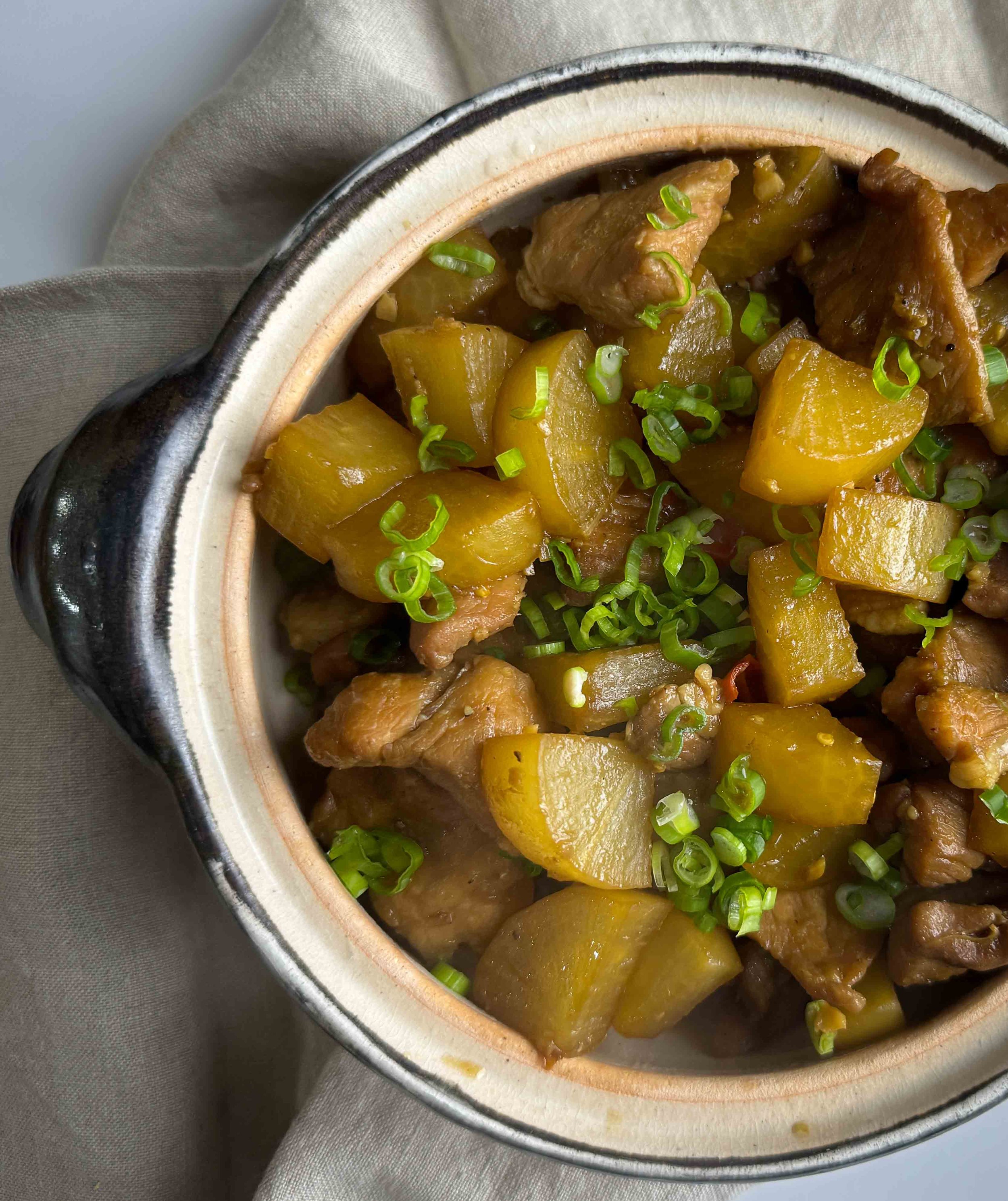Peppery Caramel Pork and Daikon (Thịt Heo Kho Củ Cải)
This earthy braise of daikon and pork — thịt heo kho củ cải — is something Andrea Nguyen craves and prepares often, she writes in Ever-Green Vietnamese, from which the recipe is adapted. It’s not a special or fancy dish, but rather what the author calls “món ăn người nghèo (poor people’s food). We were attracted to it because we love braised daikon, and it looked so warm and homey.
READ: Cookbooks We Love: Vegetables are the stars of Andrea Nguyen’s ‘Ever-Green Vietnamese’
Caramel sauce is a cornerstone of Vietnamese cooking (along with nuoc cham dipping sauce and rice); it’s also technically a bit challenging, and needs to be made with care and attention. For that reason, Nguyen — who’s all about practicality — also gives a quickly made substitute. “The color and flavor will be good, but not as bright,” she writes.
If what you’re looking for is a simple-to-prepare weeknight comfort dish, use the shortcut. If you want to dive deeper and get serious about Vietnamese cooking, buy the book and learn to make the real-deal caramel sauce from Nguyen’s thoughtful and thorough recipe for it.
For this recipe, Nguyen calls for either lean pork belly or fatty boneless pork shoulder. When we shopped for this, we found pork belly, but it wasn’t lean, and pork shoulder, but it was too lean. Boneless pork country ribs looked just right — and they behaved perfectly in the recipe. Serve it with rice, and — if you like — slices of cucumber, plus a simple green veg, such as kale or Swiss chard.
Makes 4 servings.
Ingredients
1 1/2 tablespoons honey or agave syrup
2 teaspoons molasses
1 teaspoon rice vinegar
1 1/2 pounds / 680 grams daikon
10 ounces / 284 grams lean pork belly (with or without skin), fatty boneless pork shoulder or boneless pork country ribs
1 1/2 tablespoons fish sauce
Fine sea salt
Freshly ground black pepper
1 tablespoon neutral oil (such as canola or peanut)
2 tablespoons finely chopped shallot or yellow onion
1 tablespoon minced garlic
1/2 cup water, plus more as needed
1 or 2 Thai or small serrano chiles, or 1 small jalapeño or Fresno chile, stemmed and split lengthwise
Granulated sugar for balancing flavor
1 scallion, green part only, thinly sliced (optional)
Instructions
1. To make the faux caramel sauce, combine the honey or agave syrup, the molasses and the vinegar in a small bowl. Set aside.
2. Peel the daikon, quarter it lengthwise and cut it cross-wise into bite-sized chunks. Set aside.
3. Cut the pork into mini-domino sized pieces. If you’re using pork belly, cut it across the grain into rectangular chunks, then slice the chunks into 1/4-inch / 7 mm pieces. If using pork shoulder or country ribs, do your best to cut it into similar-sized pieces, getting a little fat with the lean. Put the pork in a bowl, add the faux caramel sauce, the fish sauce, a generous 1/2 teaspoon salt and a generous 1/2 teaspoon pepper, and toss gently to combine.
4. Set a large saucepan over medium heat and add the neutral oil. When the oil begins to ripple, add the shallots and garlic. Stir and cook for 1 to 2 minutes, until some pieces turn golden. Scrape the pork into the saucepan, stir in the water and then raise the heat to bring to a vigorous simmer. Cover, lower the heat to continue simmering, and let cook for 10 minutes, stirring occasionally (turn the heat down if steam poofs from under the lid).
5. Uncover the pan, add the daikon and chiles, stir and re-cover. Return to a vigorous simmer and cook, stirring a few times, for 8 to 15 minutes, until the pork is firm-tender and the daikon pieces are just tender. Test for doneness by poking a knife tip into a piece of pork and a large daikon chunk. If the sauce in the pan isn’t rich or potent enough, let it simmer, uncovered, for a few minutes to concentrate the liquid. Turn off the heat, cover and let rest for 5 minutes to finish cooking and meld flavors.
6. If there’s to much fat from the pork, tilt the pan and use a metal spoon to remove as much as you like; save it for other uses. Taste and, if the flavor seems wimpy, add a sprinkling of salt, fish sauce, pepper and sugar to create a savory-spicy-sweet finish. If things are too salty or you just want more sauce, stir in water by the tablespoon (reheat to combine). Transfer the mixture to a shallow bowl and garnish with the scallion, if desired.
Want free recipes delivered to your inbox? Sign up below!

Peppery Caramel Pork and Daikon (Thịt Heo Kho Củ Cải)
Ingredients
- 1 1/2 tablespoons honey or agave syrup
- 2 teaspoons molasses
- 1 teaspoon rice vinegar
- 1 1/2 pounds / 680 grams daikon
- 10 ounces / 284 grams lean pork belly (with or without skin), fatty boneless pork shoulder or boneless pork country ribs
- 1 1/2 tablespoons fish sauce
- Fine sea salt
- Freshly ground black pepper
- 1 tablespoon neutral oil (such as canola or peanut)
- 2 tablespoons finely chopped shallot or yellow onion
- 1 tablespoon minced garlic
- 1/2 cup water, plus more as needed
- 1 or 2 Thai or small serrano chiles, or 1 small jalapeño or Fresno chile, stemmed and split lengthwise
- Granulated sugar for balancing flavor
- 1 scallion, green part only, thinly sliced (optional)
Instructions
- To make the faux caramel sauce, combine the honey or agave syrup, the molasses and the vinegar in a small bowl. Set aside.
- Peel the daikon, quarter it lengthwise and cut it cross-wise into bite-sized chunks. Set aside.
- Cut the pork into mini-domino sized pieces. If you’re using pork belly, cut it across the grain into rectangular chunks, then slice the chunks into 1/4-inch / 7 mm pieces. If using pork shoulder or country ribs, do your best to cut it into similar-sized pieces, getting a little fat with the lean. Put the pork in a bowl, add the faux caramel sauce, the fish sauce, a generous 1/2 teaspoon salt and a generous 1/2 teaspoon pepper, and toss gently to combine.
- Set a large saucepan over medium heat and add the neutral oil. When the oil begins to ripple, add the shallots and garlic. Stir and cook for 1 to 2 minutes, until some pieces turn golden. Scrape the pork into the saucepan, stir in the water and then raise the heat to bring to a vigorous simmer. Cover, lower the heat to continue simmering, and let cook for 10 minutes, stirring occasionally (turn the heat down if steam poofs from under the lid).
- Uncover the pan, add the daikon and chiles, stir and re-cover. Return to a vigorous simmer and cook, stirring a few times, for 8 to 15 minutes, until the pork is firm-tender and the daikon pieces are just tender. Test for doneness by poking a knife tip into a piece of pork and a large daikon chunk. If the sauce in the pan isn’t rich or potent enough, let it simmer, uncovered, for a few minutes to concentrate the liquid. Turn off the heat, cover and let rest for 5 minutes to finish cooking and meld flavors.
- If there’s to much fat from the pork, tilt the pan and use a metal spoon to remove as much as you like; save it for other uses. Taste and, if the flavor seems wimpy, add a sprinkling of salt, fish sauce, pepper and sugar to create a savory-spicy-sweet finish. If things are too salty or you just want more sauce, stir in water by the tablespoon (reheat to combine). Transfer the mixture to a shallow bowl and garnish with the scallion, if desired.




